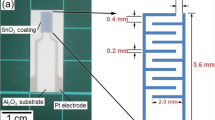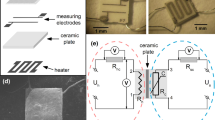Abstract
Nitrogen oxides (NOx) and carbon monoxide (CO) are among the most dangerous chemical species to human health present in the atmosphere. Acute CO toxicity leading to unconsciousness, respiratory failure or death can occur after 1 hr of exposure when ambient CO levels reach 1000 ppm, whilst increase of NOx emissions can contribute to acid deposition, pollution of groundwater, eutrophication of surface waters, and tropospheric ozone and ecosystem damage. In this work, pure SnO2 sensors for CO and NOx were prepared by spin coating solutions derived from a washed Gel-precipitate followed by a calcining step. SnO2 sensors of nanometer grain size prepared by this process showed good sensitivity to CO and NOx gases. The increase of calcining temperature not only affected grain size and surface morphology, but also caused a decrease in sensitivity of the SnO2 sensors.
Similar content being viewed by others
References
S. G. Ansari, P. Boroojerdian, S. R. Sainkar, R. N. Karekar, R. C. Aiyer, and S. K. Kulkarni,Thin Solid Films 295, 271 (1997).
N. S. Baik, G. Sakai, N. Miura, and N. Yamazoe,Sensors & Actuators B 63, 74 (2000).
M. S. Kwak, J. H. Lee, J. S. Hwang, and C. O. Park,Metals and Materials 5, 351 (1999).
S. T. Omaye,Toxicology 180, 139 (2002).
J. A. van Ardenne, G. R. Carmichael, H. Levy, II, D. Streets, and L. Hordijk,Atmospheric Environment 33, 633 (1999).
M. Fleischer and H. Meixner,Sensors & Actuators B 52, 179 (1998).
J. D. Wright and N. A. J. M. Sommerdijk,Sol-Gel Materials: Chemistry and Application, Gordon and Breach Science Publishers, Amsterdam (2001).
A. Diéguez, A. Vila, A. Cabot, A. Romano-Rodriguez, J. R. Morante, J. Kappler, N. Bârsan, U. Weimar, and W. Göpel,Sensors & Actuators B 68, 94 (2000).
Z. Jin, H. J. Zhou, Z. L. Jin, R. F. Savinell, and C. C. Liu,Sensors & Actuators B 52, 188 (1998).
A. Diéguez, A. Romano-Rodriguez, J. R. Morante, U. Weimar, M. Schweizer-Berberich, and W. Göpel,Sensors & Actuators B 31, 1 (1996).
G. Zhang and M. Liu,Sensors & Actuators B 69, 144 (2000).
R. E. Reed-Hill and R. Abbaschian,Physical Metallurgy Principles, PWSKent Publishers, Boston, USA (1992).
T. Becker, S. Ahlers, C. B. Braunmuhl, G. Muller, and O. Kiesewetter,Sensors & Actuators B 77, 55 (2001).
Author information
Authors and Affiliations
Corresponding author
Rights and permissions
About this article
Cite this article
Cha, GY., Bui, AH., Baek, WW. et al. Effects of calcining temperature on SnO2 sensors for CO and NOx gases. Met. Mater. Int. 10, 149–152 (2004). https://doi.org/10.1007/BF03027318
Issue Date:
DOI: https://doi.org/10.1007/BF03027318




